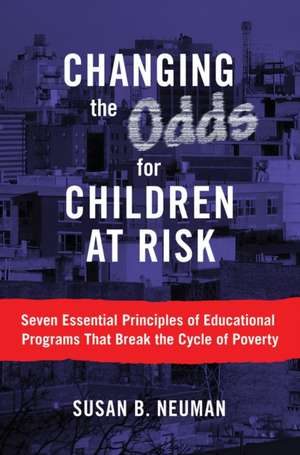Changing the Odds for Children at Risk: Seven Essential Principles of Educational Programs That Break the Cycle of Poverty
Autor Susan B. Neumanen Limba Engleză Paperback – 30 noi 2009
Preț: 207.25 lei
Nou
Puncte Express: 311
Preț estimativ în valută:
39.66€ • 42.41$ • 33.07£
39.66€ • 42.41$ • 33.07£
Carte indisponibilă temporar
Doresc să fiu notificat când acest titlu va fi disponibil:
Se trimite...
Preluare comenzi: 021 569.72.76
Specificații
ISBN-13: 9780807750483
ISBN-10: 0807750484
Pagini: 225
Dimensiuni: 155 x 231 x 15 mm
Greutate: 0.36 kg
Editura: Teachers College Press
ISBN-10: 0807750484
Pagini: 225
Dimensiuni: 155 x 231 x 15 mm
Greutate: 0.36 kg
Editura: Teachers College Press
Notă biografică
Susan B. Neuman is a Professor in Educational Studies at the University of Michigan, School of Education. Previously she has served as the U.S. Assistant Secretary of Elementary and Secondary Education.
Cuprins
IntroductionCh 1: The Critical Early Years for Changing the OddsCh 2: Changing the Odds by Funding What WorksCh 3: The Seven Essentials for Changing the OddsCh 4: Changing the Odds by Helping to Strengthen FamiliesCh 5: Changing the Odds through Quality Early Care and EducationCh 6: Changing the Odds through Community-Based ProgramsCh 7: Changing the Odds through After-School ProgramsCh 8: The Public Will: What it Will Take to Change the Odds
Recenzii
Extremely well written, this book belongs in libraries supporting educators, parents, researchers, and policy-makers.
Neumann writes a practical book of solutions, as offered through her "seven essentials" for changing the odds for at-risk kids and their families. These aren't theories. These are principles of educational programs that are proving themselves to work in several different places around the country. . Her ideas are the type of educational stimulus plan needed to save the futures of millions of young Americans who otherwise may perish.
Every educator--experienced, as well as novice--will rejoice at the thought that things can improve, and moreover, are improving in the education of every child, regardless of material goods or social standing. Neuman presents a blueprint for every child in America.
Neuman refers to her audience as 'policy makers, practitioners, parents, and community leaders' who could help disadvantaged children (p. 70). However, readers interested in principles based on empirical studies and calls for action from those qualified to perform educational and performance-based testing, longitudinal studies, program assessment, individual testing, correlation studies, and research design assessment would also find this book useful. . . . Neuman successfully achieves what seems to be the book's purpose, to convince readers that there is enough funding already in place to help children at risk, that programs exist that can help at-risk children, and that programs that cannot bring forth fruits of success should be jettisoned.
Neumann writes a practical book of solutions, as offered through her "seven essentials" for changing the odds for at-risk kids and their families. These aren't theories. These are principles of educational programs that are proving themselves to work in several different places around the country. . Her ideas are the type of educational stimulus plan needed to save the futures of millions of young Americans who otherwise may perish.
Every educator--experienced, as well as novice--will rejoice at the thought that things can improve, and moreover, are improving in the education of every child, regardless of material goods or social standing. Neuman presents a blueprint for every child in America.
Neuman refers to her audience as 'policy makers, practitioners, parents, and community leaders' who could help disadvantaged children (p. 70). However, readers interested in principles based on empirical studies and calls for action from those qualified to perform educational and performance-based testing, longitudinal studies, program assessment, individual testing, correlation studies, and research design assessment would also find this book useful. . . . Neuman successfully achieves what seems to be the book's purpose, to convince readers that there is enough funding already in place to help children at risk, that programs exist that can help at-risk children, and that programs that cannot bring forth fruits of success should be jettisoned.
